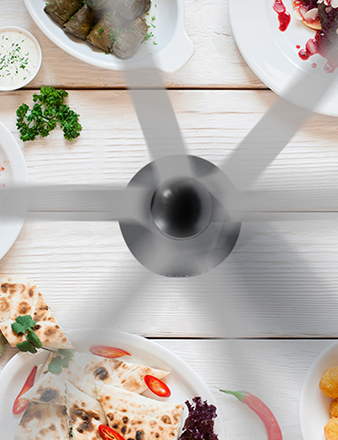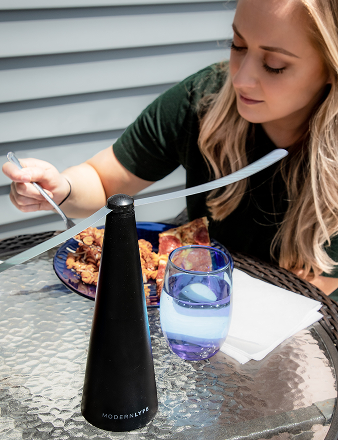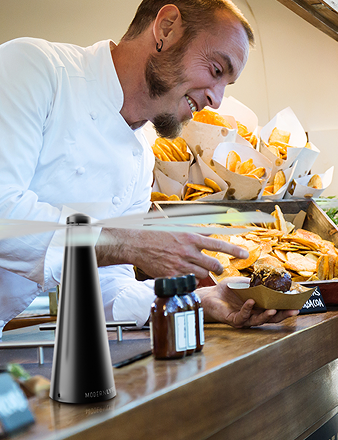Imagine a professional's ultimate go-bag. Not just a laptop and a charger, but a complete, self-contained operational system ready to deploy anywhere in the world at a moment's notice. That's a fly away kit. These aren't just rugged cases full of gear; they're fully integrated command centers designed to bring critical capabilities to places that have none.
What is a Fly Away Kit?
Think of a fly away kit as an entire operational base, expertly packed into airline-checkable cases. It's more than a collection of tools—it's a pre-configured, self-sufficient system built to be up and running the second it hits the ground.
The concept is like a paramedic's medical bag. They don't start packing when an emergency call comes in; they have a kit ready with everything needed to stabilize a patient, organized for instant access. A fly away kit does the same, containing all the hardware and software required to set up a secure communications hub, a cyber defense outpost, or a field broadcasting studio in minutes.
The design philosophy behind every kit follows three non-negotiable principles:
- Portability: Everything is packed into durable, often wheeled cases that meet airline regulations for checked baggage. This allows them to be transported on commercial or military flights without logistical headaches.
- Durability: The gear is housed in ruggedized containers built to survive rough handling and harsh environments, from chaotic disaster zones to remote military outposts.
- Rapid Deployment: Every cable, switch, and server is pre-wired and configured for lightning-fast assembly. A trained operator can typically get a full kit operational in under 30 minutes.
Who Relies on Fly Away Kits?
The need for these mobile systems cuts across numerous industries—any field where failure isn't an option. They are vital for any team that must operate far from traditional infrastructure.
For example, emergency responders use them to restore communication networks after a hurricane or earthquake, allowing them to coordinate search and rescue missions when local cell towers are down. Similarly, journalists and broadcasters rely on them to transmit high-definition video from remote locations, bringing live news to a global audience.
A fly away kit is the bridge between a remote location and the rest of the world. It provides the technological backbone that enables teams to perform their duties effectively, regardless of how austere the environment is.
So, what's actually inside? While the exact contents change based on the mission, the core components are generally consistent.
Core Components of a Typical Fly Away Kit
This table provides a quick overview of the essential hardware and software you'd commonly find packed inside.
| Component Category | Primary Function | Common Equipment Examples |
|---|---|---|
| Connectivity | Establishes a link to the outside world | Satellite terminals (VSAT), cellular bonding devices, Starlink dish, Ethernet/fiber converters |
| Networking | Creates a local network and manages data flow | Ruggedized routers, network switches, firewalls, Wi-Fi access points |
| Computing & Storage | Provides processing power and data storage | Small form-factor servers, rugged laptops, Network Attached Storage (NAS) devices |
| Power | Ensures continuous operation without a grid | Uninterruptible Power Supply (UPS), portable generators, batteries, solar panels |
| Software | Runs mission-specific applications | VPN clients, video encoding software, network monitoring tools, cybersecurity suites |
| Peripherals | Allows for user interaction and specialized tasks | Monitors, keyboards, mice, VoIP phones, tactical headsets, specialized sensors |
Ultimately, having this gear pre-integrated and ready to go is what makes these kits so powerful.
More Than Just Hardware
A fly away kit isn't just about the technology it holds; it's about the capability it delivers. It gives an organization the power to extend its reach far beyond the walls of a fixed office.
For a military unit, it means establishing a secure command post on the fly. For a cybersecurity team from a firm like Mandiant, it’s having the tools to conduct on-site vulnerability assessments or incident response without delay.
These kits directly solve the logistical nightmares of modern fieldwork. They eliminate the need to source equipment in a foreign country or ship bulky systems ahead of time, which almost always leads to costly delays. By providing a complete, ready-to-go solution, fly away kits ensure professionals have the exact tools they need, right when and where they need them most.
Why You Need a Fly Away Kit for Mobile Operations
Let's face it: missions rarely happen in a perfect world with stable power, four walls, and reliable internet. The real value of a fly away kit shines when traditional infrastructure is unreliable, has been destroyed, or never existed in the first place.

Picture a disaster response team arriving in a town just hit by a hurricane. Power lines are down, cell towers are gone, and every second counts. This is when a fly away kit becomes a lifeline, spinning up an instant command center to coordinate rescue efforts when nothing else works.
It's the same story for a news crew reporting from deep in the Amazon or a military unit setting up a forward operating base. They all face the same core problem: needing rock-solid, high-speed connectivity where there is none. This demand for dependable operations anywhere on the planet is exactly why these kits have become essential.
The Driving Force Behind the Market
This growing need for on-the-go solutions has kicked the market into high gear. The Flyaway VSAT Terminal Market was valued at USD 641.81 million in 2024 and is projected to reach USD 973.12 million by 2030. That directly reflects how much sectors like disaster response, military operations, and live broadcasting rely on this technology.
This boom isn't just about demand; it's also a story of technological progress. Today's kits are leagues ahead of older versions, packing more power into smaller packages. This is thanks to a few key breakthroughs:
- Shrinking Electronics: Powerful servers, routers, and switches that once filled entire racks now fit into a single rugged case.
- Better Satellite Tech: The rise of high-throughput satellites and powerful antennas means teams get faster speeds with smaller, lighter gear.
These advancements have solved huge logistical headaches, transforming what used to be a heavy, complicated setup into something one or two people can deploy in minutes.
A fly away kit essentially erases geography as an obstacle. It lets teams bring their full operational power with them, transforming a patch of dirt in the middle of nowhere into a fully connected, functional workspace.
Where Fly Away Kits Make a Real-World Difference
To understand their impact, look at the specific problems they solve on the ground. Each scenario presents a unique challenge that only a self-contained, portable system can handle. While these missions are often complex, the core idea of being prepared applies to everything—even a casual day out requires the right equipment, which is why we put together a guide on essential accessories for a picnic.
Common Use Cases:
- Emergency Management: After a natural disaster, first responders use these kits to get voice and data comms running. This is crucial for coordinating rescue teams, managing supplies, and communicating with command centers.
- Broadcast Media: Journalists deploy kits to stream live, HD video from breaking news events in remote locations, getting the story out to the world in real-time.
- Military and Defense: Special forces units depend on fly away kits to establish secure, encrypted networks for command and control, intelligence gathering, and coordinating movements in hostile environments.
- Corporate Continuity: A business can use a kit to maintain operations. If the main office loses power or internet, a team can set up at a temporary location and keep critical systems online without missing a beat.
Ultimately, the demand for fly away kits comes down to a fundamental need: the ability to do your job effectively, no matter where you are. They are the ultimate tool for turning any remote location into a connected and capable hub.
A Look at the Different Types of Fly Away Kits
You wouldn't send a plumber to do an electrician's job or give them the same tools. The same principle applies to fly away kits. They aren't one-size-fits-all; they are highly specialized systems built for specific missions. Their real power comes from being tailored to the task at hand.
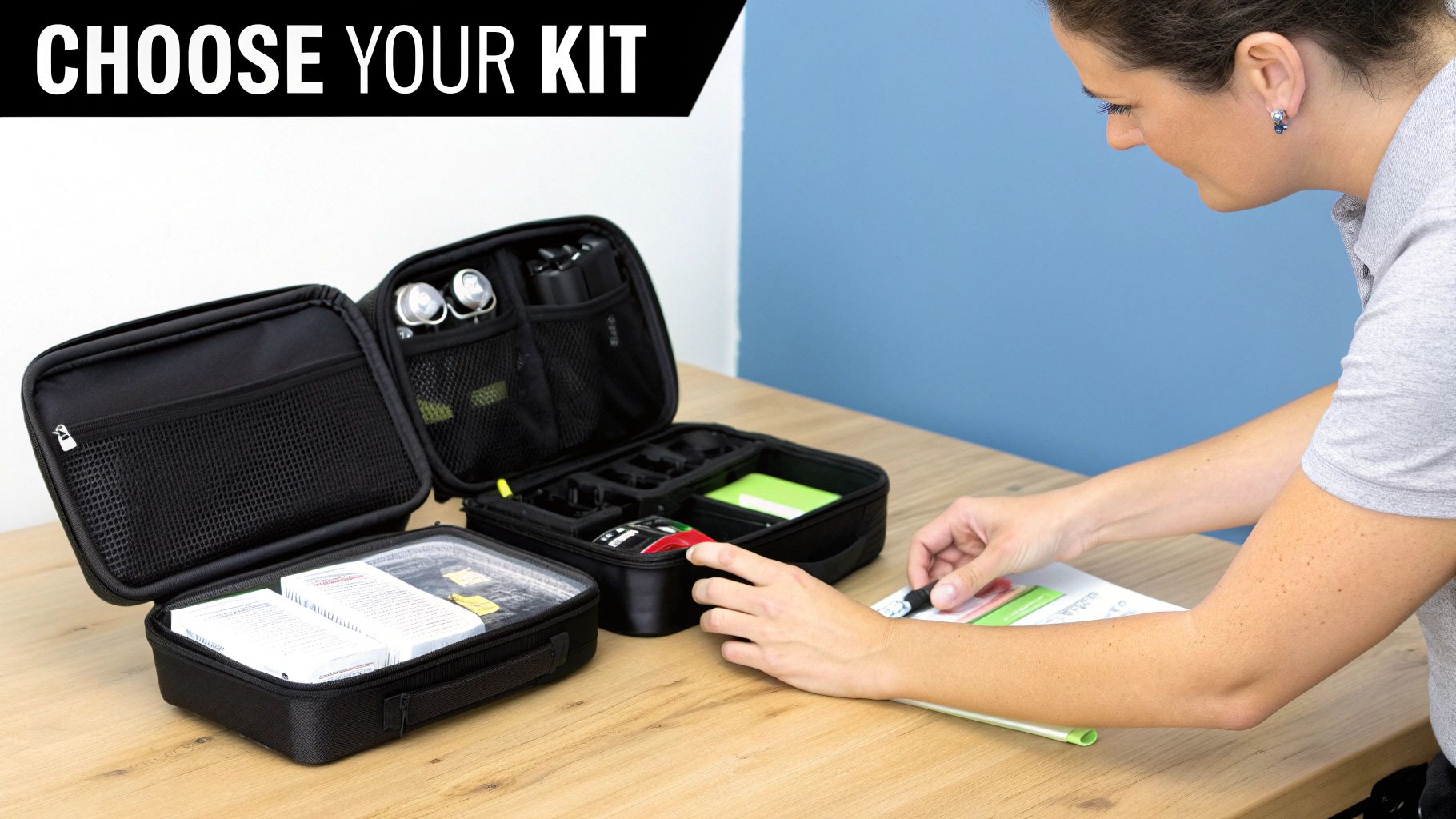
Whether it's setting up a satellite link in a disaster zone or hunting for digital threats on a secure network, each kit is a purpose-built solution. Let’s break down the main categories to see how their technology and applications differ.
Communications Kits: The Global Lifeline
At their core, communications fly away kits are designed to do one thing exceptionally well: establish a reliable voice and data link where none exists. They are the foundation of any remote operation, providing the connectivity that everything else depends on.
Imagine a geological survey team deep in a mountain range, hundreds of miles from the nearest cell tower. Their communications kit, likely equipped with a VSAT or BGAN satellite terminal, lets them send critical data back to headquarters in real-time. That instant connection is a game-changer for both safety and operational success.
These kits are essential for:
- Disaster Response Teams: Setting up on-the-ground communication hubs to coordinate rescue efforts.
- Energy and Mining Crews: Connecting remote exploration sites for data transfer and crew welfare.
- Government Agencies: Providing secure, independent communication channels during critical events.
Cyber Operations Kits: The Digital Shield
In a world where conflicts are increasingly fought online, the ability to deploy cyber capabilities anywhere is non-negotiable. Cyber operations fly away kits are essentially portable Security Operations Centers (SOCs), packed with the tools needed to defend networks, hunt for threats, and respond to incidents on the spot.
Think of a defensive cyber team flying to a forward military base to investigate a suspected network breach. Their kit contains ruggedized servers, firewalls, and forensic analysis tools, allowing them to plug directly into the local network, find the threat, and neutralize it before it causes real damage. Demand for these mobile cyber systems is growing fast.
These kits aren't just for defense. They represent a fundamental shift in cybersecurity, allowing experts to bring their full analytical power directly to the front lines of any digital conflict, no matter the location.
The importance of these systems is clear from their adoption by defense and intelligence agencies. For instance, Sealing Technologies (SealingTech), a Parsons subsidiary, delivered over 500 Cyber-Fly-Away Kits to U.S. defense and intelligence customers in the fourth quarter of 2024 alone, a contract worth over $26 million. You can read more about how these kits are being used to enhance global cyber operations.
Broadcast Media Kits: Getting the Story Out
When breaking news happens in a remote location, broadcast media kits are how journalists get high-definition video feeds back to the studio. These setups are fine-tuned for one primary job: encoding and transmitting massive video files over satellite or bonded cellular networks.
Imagine a news crew covering an international sporting event in a country with shaky infrastructure. Their broadcast kit lets them set up a temporary studio on-site. This ensures they can stream live interviews and event coverage to a global audience without relying on unpredictable local networks.
The core technology usually includes:
- Video Encoders: To compress HD or 4K video for efficient transmission.
- Satellite Modems: For a rock-solid uplink connection from anywhere.
- Bonded Cellular Devices: To combine multiple cellular signals for extra bandwidth and redundancy.
Medical First Responder Kits: Telemedicine on the Move
Medical fly away kits are revolutionizing emergency healthcare. They bring advanced diagnostic tools and expert consultations to the patient's side, no matter how remote. These kits extend the reach of doctors and specialists far beyond hospital walls.
Consider a medic on a humanitarian mission treating a patient in a rural village. Using a medical fly away kit, they can perform an ultrasound or an EKG and instantly send the results to a cardiologist thousands of miles away. This type of telemedicine leads to faster, more accurate diagnoses and can be a lifesaver in critical situations where immediate evacuation isn't an option.
The Tech That Makes It All Work
What's inside these kits that makes global communication possible from anywhere? It all comes down to powerful satellite and antenna technology. This hardware is your direct line to the outside world, completely bypassing local infrastructure that might be damaged, overloaded, or non-existent.

The star of the show is typically a VSAT, which stands for Very Small Aperture Terminal. This is a powerful, portable satellite dish built to get you online, fast. It creates a private, two-way connection with a satellite thousands of miles up in orbit, giving you reliable internet and voice services no matter where you are.
This is how a news crew can broadcast live from a conflict zone or how an energy company can pull data from a remote pipeline. The entire system is self-sufficient. As long as the antenna can see the sky, you have a connection.
The Antenna Trade-Off: Power vs. Portability
When choosing an antenna, you'll encounter a classic engineering trade-off: size. The dish—or reflector—is what captures and sends the signal, and a bigger reflector simply does a better job, providing more bandwidth and a more stable link.
For example, a larger 1.8m antenna can pull in weaker signals and deliver the high-speed performance needed for streaming HD video or keeping an entire command post connected. The catch? It's heavier and bulkier, which means it takes more effort to transport and set up.
On the other hand, a smaller antenna—under one meter—is incredibly easy to transport. It's lightweight, and a single person can have it up and running in minutes. This is perfect for grab-and-go missions where speed and a small footprint are critical, even if it means working with slightly lower data speeds. The choice always comes down to mission demands.
A Growing Market for Powerful Portability
The need for this kind of high-performance, portable connectivity is booming. The market for 1.8m flyaway antennas was valued at USD 355.15 million in 2024 and is expected to climb to USD 383.49 million in 2025. This isn't surprising given their use in broadcast media, disaster relief, and military operations—fields where a solid, high-speed link is non-negotiable. You can find more market insights and data on these trends.
Satellite Frequencies: Choosing Your Lane
To understand how these antennas work, it helps to know the different satellite frequencies they use. Think of them as radio channels. Just like AM and FM, satellite communications have their own bands—primarily C-Band, Ku-Band, and Ka-Band. Each offers a unique mix of reliability, speed, and coverage.
Think of it this way: picking a frequency band is like picking the right tool for the job. You wouldn't use a delicate instrument in a rainstorm or a blunt tool for a precision task. The same logic applies here.
Here's a quick rundown of how they compare:
- C-Band: This is the reliable workhorse of the satellite world. Like a powerful AM radio signal, C-Band is incredibly resistant to bad weather like heavy rain or snow (known as "rain fade"). Its main drawback is that it requires a larger antenna.
- Ku-Band: This is the versatile middle ground, like a popular FM station. Ku-Band strikes a great balance between power and performance, allowing for smaller antennas than C-Band while still delivering solid speeds. It's the go-to choice for a huge range of applications, though it is more susceptible to rain fade.
- Ka-Band: This is the high-speed specialist. Think of it as crystal-clear digital audio. Ka-Band delivers blazing-fast download and upload speeds, which is ideal for bandwidth-hungry tasks. The trade-off is that it’s the most sensitive to weather and requires pinpoint-accurate antenna alignment.
Understanding these core components—the VSAT antenna, the size-versus-performance equation, and the different frequency bands—is key to seeing why a fly away kit is such an indispensable tool for staying connected in the toughest environments.
How To Choose The Right Fly Away Kit
Choosing the right fly away kit isn't about grabbing the one with the most features; it’s a mission-driven decision. The perfect setup for a cybersecurity team would be completely wrong for a broadcast news crew. You have to start by clearly defining what you need to accomplish.
Think of it like packing for a trip. You don't just throw clothes in a bag. You consider your destination, the duration, and your activities. The same logic applies here, making a complex technical choice surprisingly straightforward.
This image drives the point home, showing how different factors shape what you’d pack for a trip—a principle that translates directly to selecting the right gear for your kit.
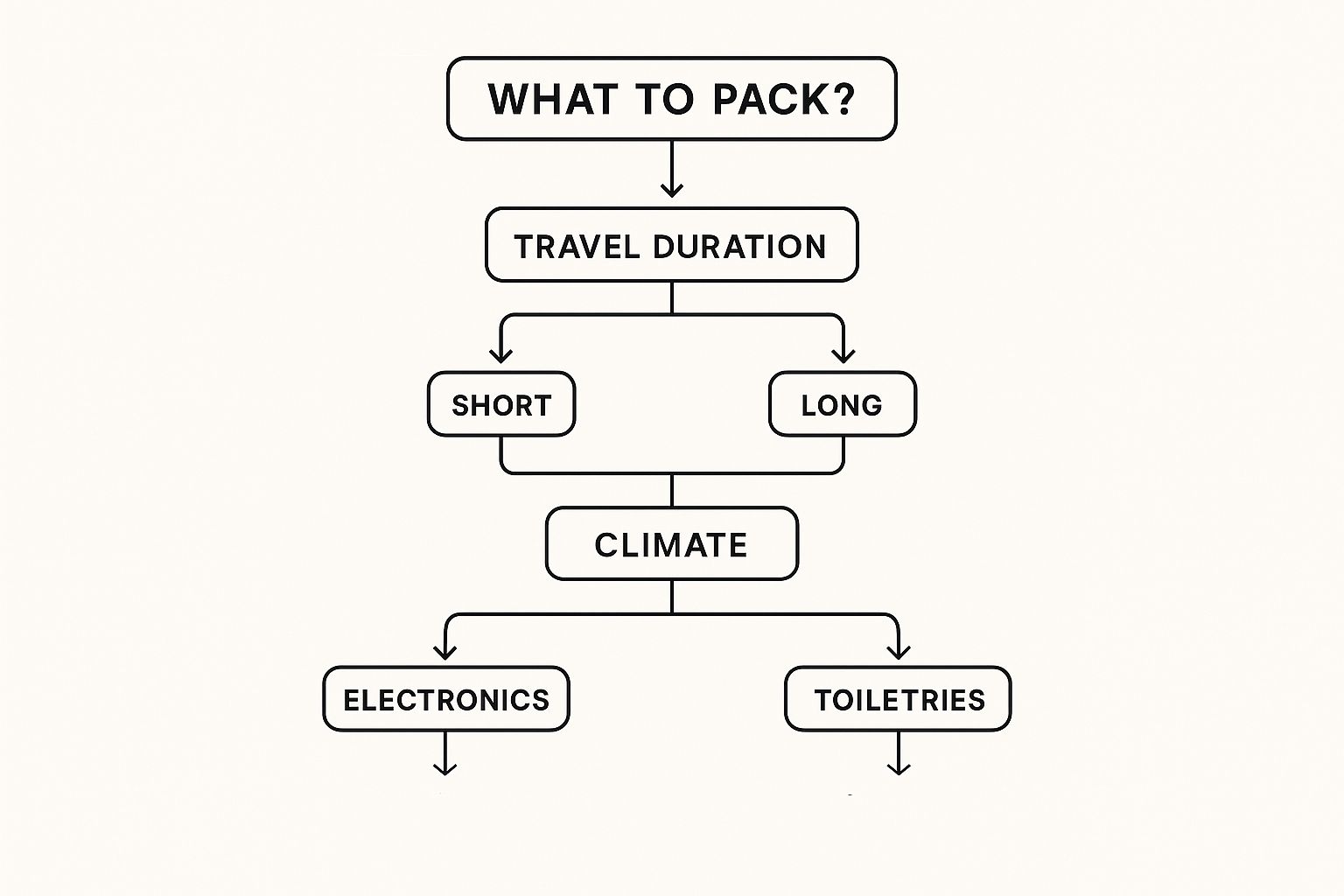
The key takeaway? Your mission dictates every single component, from the power supply to the software. Get that right, and your kit will be a reliable tool, not a frustrating liability.
Define Your Primary Mission
Before you look at any hardware, answer one question: what is the most important job this kit must do?
Is it establishing basic internet for a small field team? Streaming high-definition video from a remote location? Or conducting sensitive network forensics on-site?
Your answer changes everything. A disaster response team needs rock-solid voice and data communications above all else. Their kit will be built around a rugged, easy-to-deploy satellite terminal. They don't need the massive upload bandwidth that a media team considers essential.
Assess Your Portability and Deployment Needs
Next, consider logistics. How is this kit getting to its destination, and who is setting it up? Portability is a massive factor that will quickly narrow your options.
- Weight and Size: Is the kit flying commercial? If so, it must be packed in airline-compliant cases. This means keeping each case under the typical 50-70 lbs (23-32 kg) weight limit to avoid logistical nightmares.
- Setup Time: How fast does it need to be operational? A solo operator in a high-stress environment needs a kit that is nearly self-sufficient—think auto-acquiring antennas and simple, color-coded connections. The goal should be fully operational in under 15 minutes.
- Personnel: Who is using this kit? If your team isn't full of network engineers, you need user-friendly interfaces and automated systems. This reduces training time and, more importantly, the chance of critical errors in the field.
Determine Your Data and Power Requirements
Your mission's data needs will point you to the right connectivity hardware. A small team sending daily reports has very different requirements than a mobile command center juggling multiple live data streams.
Don't forget power—it's the lifeblood of your kit. You can't assume you'll find a clean, stable power grid. Your kit must be flexible, ready to run on portable generators or vehicle power. A built-in Uninterruptible Power Supply (UPS) isn't a luxury; it's essential for maintaining stable operations. This same logic of planning applies even to personal trips; having the right camping accessories for power and convenience can make or break an excursion.
Evaluate Environmental Conditions
Finally, where will this kit be used? The environment is a silent killer of electronics. A kit built for a climate-controlled office will fail quickly in the desert, jungle, or arctic.
The best fly away kit is one that's invisible during the mission—it just works. This only happens when environmental factors are considered from the start, ensuring the hardware can withstand heat, cold, dust, and moisture without failing.
Pay close attention to the Ingress Protection (IP) rating of the equipment. This number tells you exactly how resistant it is to dust and water. A rating like IP65 means the gear is completely dust-tight and can handle being sprayed with water, making it a solid choice for harsh outdoor conditions.
Fly Away Kit Selection Matrix
This table breaks down the different tiers of fly away kits to help you visualize the options. It’s a great starting point for matching your needs to a realistic solution.
| Feature | Basic/Entry-Level Kit | Mid-Range Professional Kit | High-End/Mission-Critical Kit |
|---|---|---|---|
| Primary Use Case | Basic internet for 1-3 users, email, voice calls | HD video streaming, multi-user connectivity, VPN access | Secure C2, multi-stream HD video, cyber operations |
| Typical Bandwidth | 1-5 Mbps | 10-25 Mbps | 50+ Mbps |
| Weight per Case | Under 50 lbs (23 kg) | 50-70 lbs (23-32 kg) | Often exceeds 70 lbs (32 kg), may require freight |
| Setup Time | 10-20 minutes | 15-30 minutes | 20-45 minutes (more complex) |
| Durability (IP Rating) | IP54 (splash resistant) | IP65 (weather resistant) | IP67 (fully waterproof) |
| Typical Cost | $15,000 - $30,000 | $40,000 - $80,000 | $100,000+ |
By working through these key questions, you can methodically turn a general need into a concrete list of requirements, ensuring you invest in a fly away kit you can count on when the stakes are high.
Deployment and Maintenance: Keeping Your Kit Ready
Having a fly away kit is just the start. The real test is ensuring it works perfectly when you're under pressure. Smart deployment and regular maintenance are what make your kit a reliable tool, and that process begins long before you leave for a mission.
Always run a full pre-deployment check. This is more than a quick inventory; it means powering on every piece of gear, confirming software licenses are current, and testing all critical connections. The field is the last place you want to discover a problem.
Fast On-Site Setup
When you arrive on location, you need to get operational quickly. A well-organized kit is essential here, allowing for a smooth setup even in chaotic situations. A seasoned operator should be able to get a standard communications kit online in under 20 minutes.
Here’s a proven sequence for efficient deployment:
- Find a Spot and Power Up: First, find a stable, safe location. Connect to your power source—a generator, vehicle, or local grid—and always switch on the UPS first to protect your equipment.
- Acquire a Signal: Next, assemble your satellite antenna and lock onto a signal. While auto-acquiring systems are excellent, knowing how to manually point a dish is a crucial backup skill.
- Bring the Network Online: Power on your network hardware like routers and switches, then fire up any servers and workstations. Run a quick test to confirm your connection is stable and you're getting the expected data speeds.
Keeping Your Gear in Top Condition
The job isn't over when you pack up. To ensure your fly away kits last and are ready for the next deployment, you have to maintain them. Dust, moisture, and extreme temperatures are the enemies of sensitive electronics.
Think of your fly away kit like a high-performance vehicle. You wouldn't drive it for months without changing the oil or checking the tires. Consistent maintenance ensures it’s ready to perform at its peak the moment you need it.
After every mission, thoroughly clean all components, paying special attention to fans and air vents where dust collects. This simple step is preventative, much like how a basic fly cover for food protects your meal. Inspect all cables and connectors for wear and tear, and replace anything that looks questionable.
When not in use, store your kit in a climate-controlled environment to protect it from humidity and extreme temperatures. It's also vital to keep firmware on all your devices updated to patch security holes and improve performance. Finally, when you repack the kit, do it with care. Ensure every component is snug and secure so it doesn’t get damaged en route to the next job.
Got Questions? We've Got Answers.
Even after diving into the details, you might still have questions about how fly away kits work in the real world. Let's tackle some of the most common ones.
How Fast Can You Actually Set One Up?
This is a big one. You're in the field, time is critical, and you need to be online now. Modern kits are built for speed. A single person with basic training can typically get a standard VSAT fly away kit unpacked, assembled, and locked onto a satellite in under 15-20 minutes. The goal is always rapid deployment to get you connected with minimal delay.
What About Power? Do You Need Anything Special?
Flexibility is key. Most fly away kits are designed to be power-agnostic. You can plug them into a standard wall outlet, hook them up to a vehicle's DC power, or run them off a portable generator. For critical missions, many kits include built-in battery backups or an Uninterruptible Power Supply (UPS) to ensure you stay online even if the primary power source is unstable.
The whole point is self-sufficiency. A well-built fly away kit shouldn't care if you're in a city or the middle of nowhere; it should just work.
Are They Difficult to Travel With on Commercial Airlines?
Not at all—they’re designed for it. Most fly away kits pack down into rugged, IATA-compliant cases (like tough Pelican-style containers) that you can check just like regular luggage. This means you can hop on a commercial flight or a military transport without arranging special cargo handling.
What Kind of Training Does My Team Need?
While today's kits are much easier to use—many have auto-pointing antennas that do the hard work for you—some basic training is always a smart investment. A good training session should cover the essentials:
- Properly packing and unpacking everything to prevent damage.
- The basics of pointing the antenna, both automatically and manually.
- Configuring the modem and understanding network basics.
- Simple, on-the-spot troubleshooting for when things go wrong.
This knowledge turns a kit from a piece of equipment into a reliable lifeline, ensuring your team can solve problems quickly and stay focused on the mission.
At MODERN LYFE, we're all about smart, effective solutions that work anywhere. While our expertise is keeping your get-togethers pest-free, we can definitely appreciate the power of a well-designed kit built to solve a problem. Check out our innovative fly fans to see how we tackle our own "fly away" challenges.

